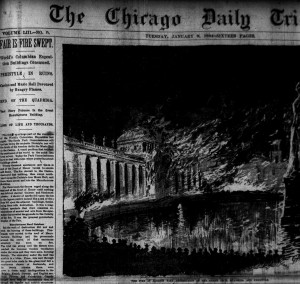From the Chicago Daily Tribune, 1/9/1894
Chicago Daily Tribune, January 9, 1894
FAIR IS FIRE SWEPT.
World’s Columbian Exposition Buildings Consumed.
PERISTYLE IN RUINS.
Casino and Music Hall Devoured by Hungry Flames.
END OF THE QUADRIGA.
Vast Fiery Furnace in the Great Manufactures Building.
LOSS OF LIFE AND THOUSANDS.
 Fire licked up a large part of the remnants of the World’s Columbian Exposition last night. The South Park Commissioners will not tear down the majestic Peristyle, nor will the touch of the wrecker defile the Music Hall of the Casino. A vexed problem that touched the sentiment of the world to the quick has been solved. Today the Park Commissioners have to deal with ruins where yesterday proud buildings stood.
Fire licked up a large part of the remnants of the World’s Columbian Exposition last night. The South Park Commissioners will not tear down the majestic Peristyle, nor will the touch of the wrecker defile the Music Hall of the Casino. A vexed problem that touched the sentiment of the world to the quick has been solved. Today the Park Commissioners have to deal with ruins where yesterday proud buildings stood.
Twenty thousand spectators saw the east end of the Court of Honor vanish in smoke and flame. The fire started in the Casino, destroyed that building, then swept northward along the Peristyle into Music Hall, and from there across and into the Manufactures Buildings.
For three hours the flames raged along the east end of the Court of Honor until nothing was left but charred timbers and blackened plaster. A shower of sparks fell upon the ice in the lagoon until it looked like a sea of fire; they fell upon the adjacent buildings, threatening them with destruction. It was a magnificent spectacle that drew ceaseless exclamations of wonder and awe from the spectators that crowded the grounds in the vicinity of the fire. It was the greatest pyrotechnic display of the Fair.
…
It is more than probable that the fire was started by tramps. They have been fairly swarming the Fair grounds since the first of the month….
…
[the flames] shot up into the air to a height of 100 feet or more. All the grounds as far north as the north lagoon were lighted up like a midsummer’s day at noon. The crowd that lined the shore could be distinctly seen in the bright light, and they could be heard, too, every time a statue or a pinnacle toppled on a crumbling cornice before taking a plunge into the fiery depths below. The crowd cheered as one after another the statues toppled and pitched head foremost, some back into the burning building, others out toward the lake.
…
The French statue of the Republic seemed to stand in the midst of it all like a gigantic silhouette, with uplifted arms as if appealing for help. The wind blew furiously, and now and then made great rifts in the smoky wall, revealing the blood-red skeleton of arch and column.
…
[In the Music Hall] The ten minutes rolled by, and it was a quarter to 9 o’clock. Then, with a rumble and a roar, the roof and all its surrounding towers fell inward into the blazing furnace and simultaneously filled the heavens with a cloud of sparks which resembled Vesuvius in action.
…
Men of mature years were grieved and thoughtful. There were many women in the crowd, and of these not a few wept. The Columbian Guards, too, were deeply touched. To them it was as though they had lost a near and dear friend, as one by one they saw the familiar landmarks of the Exposition crumble into ruin.
…
Loudest of all were the expressions of regret when it was seen that the Quadriga was doomed. For some time it had seemed as though the flames would be stopped before they had progressed that far. The fire burned slowly for more than ten minutes, the firemen had two streams playing on the Peristyle from the chocolate pavilion, the firemen from the north end of the Peristyle were working south as far as they could, and it seemed as though the battle might be ended there, but a gust of wind came up, the great cloud of sparks that had been floating down upon the lagoon shifted suddenly northward for a moment, the mute faces in the triumphal chariot were lighted up as though a searchlight had been turned on them for a single instant, then a dense pall of smoke hid them from view. They were seen no more for a few moments, then a thundering crash on the bridge across the lagoon told that the Quadriga was no more.
[the crowds were “people of the better class” and “everything was quiet and solemn and decorous”]
[while the Fair was in progress there were 3000 guards, but that number was greatly reduced two weeks after the Fair ended, and now only 240 remained; while the Fair was going every building had numerous hose reels, Babcock extinguishers and fire buckets, but those had been removed, as had the water flow to the standpipes. There had been numerous blazes during the Fair in Transportation, Manufactures, Agricultural, Machinery Hall an Electricity Buildings, mostly attributed to defective electric-light wires; the worse was the Cold Storage fire on July 10 which destroyed that building and $600,000 worth of contents, and killed ten firemen.]